![]()
Full Toolset Supporting a Complete Automotive Cycle
Our tools work well in supporting our software products and services, providing a smooth transition from design phase to end of line product customization and cataloging.
Our tools include Expert Systems for the analysis of network timings, development tools for crosslinking in automobiles, Measuring Tools for the integration of control units and Testing Tools for the production at the OEM and Tier1.
Request a quote today for the type of tool you require.
Tool Types
Click on the blue accordions below for more information.
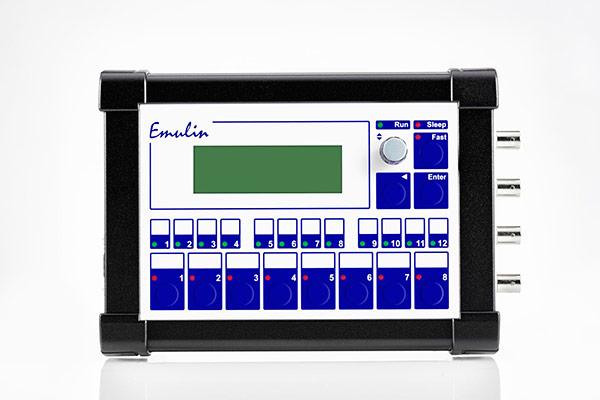
Description
Emulin is a development tool for the design and realization of LIN control devices. It is used for stand-alone operation, operation using control panel, modification of all frame timing parameters, modification / emulation of bus terminal switching, and much more.
Characteristics
- Emulation and analysis of LIN nodes / LIN subsystems / Restbus simulation
- Mobile use including inside the vehicle
- Menu-steered via LCD display
- Operating panel with 8 keys and 12 LEDs, all freely configurable
- Port interface with 2 analog /digital inputs and outputs
- CAN interface 1Mbaud for communicating with the PC or other devices
- Modification / measurement of all frame timing parameters
- Emulation / setting of the resistive and capacitive bus terminal switching
- Event-based signal configuration and sequence control
- Frame-based trigger pulse creation
- Wakeup / Sleep / Power-down capability
- Detailed LIN bus error recognition and playback
- configuration file sets savable / locally switchable
- PC program Visulin for recording and displaying measurement data and for configuring the emulator
- Easily integrated into automated testing environments (LabView, HP VEE, and others)
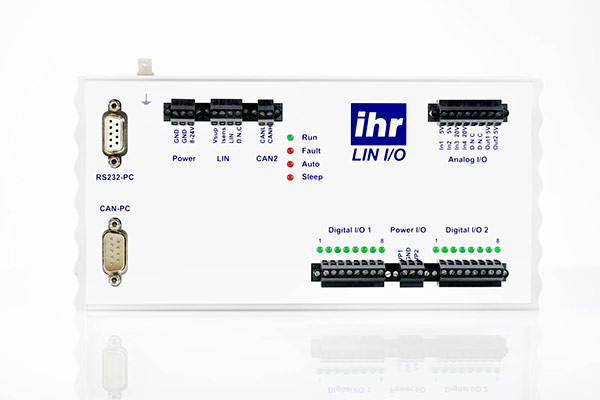
Description
LIN I/O is the communication adapter between production automation and the LIN test object. As the connection to the test automation device or SPS is generally via high-speed CAN and/or 24V digital I/O, LIN test object is not covered. LIN I/O feeds the LIN test object in a short-circuit protected manner allowing the current uptake of the test object to be measured and used in the evaluation.
The internal signal processing makes it possible to pre-process the LIN data, for example for checking the limiting values or plausibility, or for the end-of-line calibration of the control devices.
The SPS can thus be freed up and the LIN interface can independently carry out simple sequences and deliver “good/bad” evaluations to the SPS. Despite the deviation in hardware appearance, the LIN I/O is compatible with the other members of the tool family.
Characteristics
- Emulation and Analysis of LIN nodes / LIN subsystems, simulation of bus participants not actually present
- Wakeup / Sleep
- Event-based signal configuration and sequence control
- LIN bus error recognition, playback via CAN, LED and port possible
- PC program Visulin for recording and displaying measurement data, and for configuring the emulator
- Simple integration into automated test environments (LabView, HP VEE, and others)
Equipment
- Status display via LED’s
- Ohmic bus termination (master/slave/stress/overload) switchable by means of software
- Galvanically separated digital inputs/outputs (like digital I/O module)
- LED status display for digital ports
- 4 analog inputs
- 2 analog outputs, trigger creation
- 1 current measurement channel for current uptake of the test object
- Housing for the top hat rail assembly, 200 x 105 mm
- Connections designed as plugable rows of pins
Accessories
- Second CAN interface for vehicle bus (optional when placing a new order)
- CAN I/O periphery extension
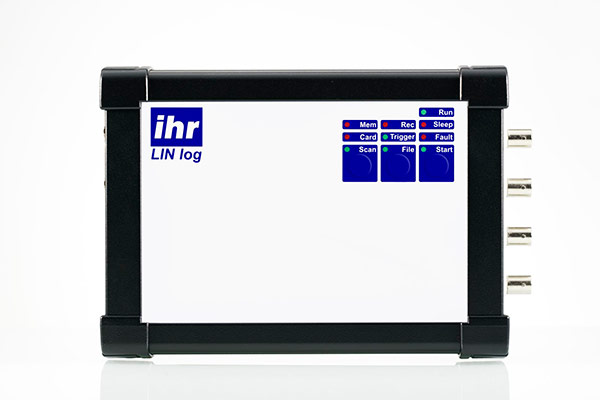
Description
This device is used to capture LIN traffic on the bus for later analysis. It is quite useful when attempting to capture LIN bus issue in the vehicle for future on-bench analysis.
Characteristics
- Monitoring of LIN nodes / LIN subsystems
- Recording of LIN bus traffic, system and measurement data, optional vehicle CAN bus trafiic
- Wakeup / Sleep monitoring
- PC program Visulin for recording and displaying measurement data, and also for configuring the logger
Equipment
- Operating interface with keys and LED’s for direct logger control
- Card slot for insertion of compact flash media
- Memory depth of up to 128MB, permits the recording of more than 6million messages
- Ohmic bus termination (master/slave/stress/overload) switchable by means of software
- Port interface with 2 analog / digital inputs and outputs, trigger creation
Accessories
- Second CAN interface for vehicle bus and gateway emulation, fully configurable
- CAN I/O periphery extension
- LINlog emulator option: Optional LINlog extension: after input of a de-energizing code the data logger can be used also as LIN/CAN emulator.
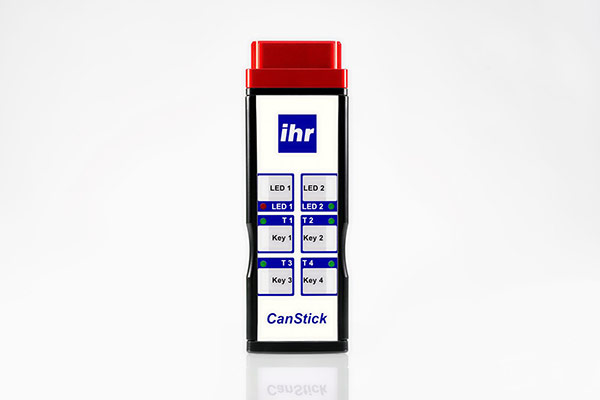
Description
The CanStick is a handy diagnostic tool for automotive applications. It is easily attachable to the OBD-2 connector of the vehicle and the operator can easily send and receive predefined CAN sequences. The tool with high contact durability is designed for the environment of serial manufacturing as well as a quick diagnostic tool in the field of R&D. With the help of four free programmable keys the user can send CAN messages and start events. Six LED’s, also free programmable, give a feedback of accomplished actions back to the operator. The device is powered by the OBD-2 connector and does not need additional supplies.
The CanStick consists of a microcontroller with its own operating system and Flash Memory (64kByte). The CAN program sequence is transmitted from the Host PC to the CanStick via a RS232 connection after which, the CanStick works automatically
To create a program for the CanStick, two software tools are required: The Compiler with the project environment and the Flash-Tool to download the binary file. The tool is accompanied with sample projects, in which the functions for key and LED´s are predefined. The message sequences can be added and then compiled, linked and flashed to the CanStick.
Configuration
- CanStick Light: CAN communication device with 4 free programmable keys and 6 free programmable LEDs. Without OBD-2 connector. Housing closed on both sides.
- CanStick Basic: CAN communication device with 4 free programmable keys and 6 free programmable LEDs. Housing closed on one side. 1 OBD-2 connector.
- CanStick Pro: CAN communication device with 4 free programmable keys and 6 free programmable LEDs: 1 OBD-2 connector & 1 OBD-2 bushing.
Accessories
Spring loaded pins (for OBD-2 connector with exchangeable pins)
Characteristics
- 4 free programmable keys
- 6 free programmable LED’s
- RS232 – connector to the Host PC (9-pin)
- MOLEX OBD-2 connector / bushing (14-pin)
- OBD-2 connector gold plated (min. 2.000.000 connection cycles) or OBD-2 connector with exchangeable spring-loaded pins. (min. 200.000 connection cycles)
- Current consumption: typical 50 mA
- Nominal voltage: typical 13,5 V (9 … 16 V)
- Short circuit protection: Diode
- Polarity protection: Diode
- Temperature range: -20°C to +70°C
- Dimensions: app. 100 x 48 x 30 mm
- Mass: app. 200 g
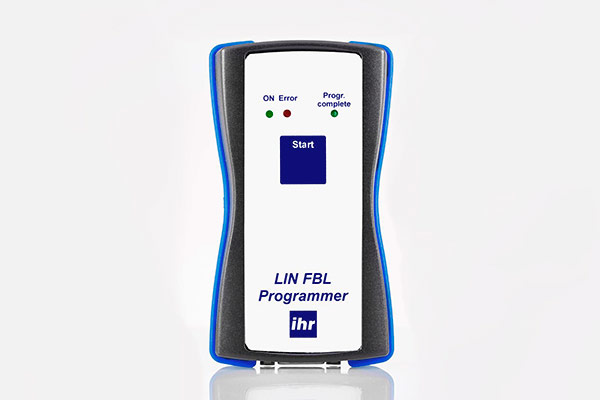
Description
LIN Firmware programmer is a standalone device used for flashing Firmware based on LIN and UDS Layer.
Characteristics
- Rest Bus Simulation
- Flashing of Hex via UDS Services
- SD Card Operation
- 1 Programming Key
- 3 LEDs
- Stand Alone Operation
- Automatic Function
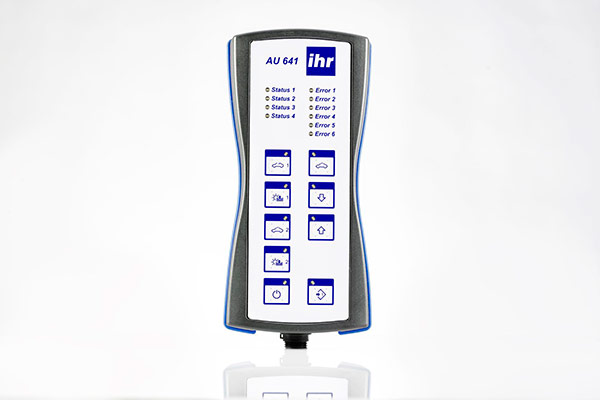
Description
This device is used for operating SADs as well as shades MD1, MR1, MD2, MR2 according to specification “Operating Device SAD641 V1.7”
Characteristics
- Remaining Bus Simulation
- 9 Keys
- 19 LEDs
- Stand Alone Mode
- Automatic Function
Scope of supply
- SAD 641 in Plastic Case
Supported Sun Roofs
- AU316 (Q3) 8U0 959 591
- AU571 (A6) 7P5 959 591
- AU571 (A6) 4GD 959 591 Cod. 00
- AU572 (A6 Avant) 4G9 959 591
- AU572 (A6 Avant) 4GD 959 591 Cod. 01
- AU573 (A7) 7P5 959 591
- AU641 (A8) 4H0 959 591 / -A
- AU641-LWB (A8L) 4H4 959 591
- VW526 (Touareg) 7P0 959 591
- PO726 (Cayenne) 7P0 959 591
- AU210 (A1) 8X0 959 591
- AU37X (A3) 8V3 959 591
Request a Quote
"*" indicates required fields
